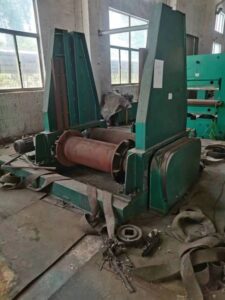Rubber PVG Conveyor Belt Making Machinery

In the industrial sector, the production of rubber PVG (Polyvinyl Chloride solid woven) conveyor belts involves various intricate processes and specialized machinery. These Rubber PVG Conveyor Belts find extensive use in diverse industries due to their durability, flexibility, and resistance to abrasion, making them ideal for conveying materials. Understanding the machinery involved, their functionalities, and the market dynamics is crucial for comprehending the manufacturing process of these conveyor belts.
1. Types of Machinery Required-
The production of Rubber PVG Conveyor Belt involves a series of machinery, each serving a specific purpose:
i)Mixing Mill:
A mixing mill is the first machine employed in the process, which is meant to mix and homogenize raw materials such as natural rubber, synthetic rubber, carbon black, plasticizers, and other additives. The equipment produces a uniform and consistent mixture, which is fundamental for the end product quality.

ii)Calender Machine:
Following the mixing process, the compounded rubber is passed through a calender machine. This machine consists of several rollers that compact and flatten the rubber into thin sheets of uniform thickness. These sheets serve as the base material for the conveyor belt.
iii)Press Machine:
The calendered rubber sheets are further processed in a press machine, where they undergo heating and pressing to create layers. These layers include the fabric (for reinforcement) and the cover layers, forming the core structure of the conveyor belt.
iv)Vulcanizing Machine:
Vulcanization is a critical process that imparts strength and durability to the conveyor belt. The rubber layers and fabric are subjected to high temperatures and pressure in a vulcanizing machine. This process cross-links the rubber molecules, enhancing the belt’s strength and resilience.
2. Working of All Machinery-
The process initiates with the mixing mill where raw materials are blended to form a consistent compound. Subsequently, this compound is fed into the calendar machine, which shapes it into uniform sheets. The press machine then assembles these sheets into layers, incorporating fabric for reinforcement.
Once the layers are assembled, they enter the vulcanizing machine, where heat and pressure trigger the cross-linking of rubber molecules, forming a cohesive and robust conveyor belt. Post-vulcanization, the belts undergo quality checks for dimensions, tensile strength, flexibility, and other parameters to ensure adherence to standards.
3. Market Analysis of Rubber Conveyor Belt-
The Rubber PVG Conveyor Belt market remains robust due to the constant demand across industries like mining, manufacturing, transportation, and logistics. The global market witnesses steady growth owing to infrastructural developments and expanding industrialization across regions.
Notably, companies like Vatsn Tecnic have a significant presence in the market as sellers and stockists of secondhand and used rubber machinery. They play a pivotal role in providing cost-effective solutions to manufacturers looking to expand or establish conveyor belt production lines. Their offerings contribute to the accessibility of machinery for businesses entering or expanding within the industry.
Complex machinery produces rubber PVG conveyor belts. This machinery requires precision and specialized equipment. The market demands these belts. Vatsn Tecnic offers secondhand machinery, driving growth in conveyor belt production. In conclusion, the manufacturing process of conveyor belts is important. It requires precision and specialized equipment.

 Compression Molding
Compression Molding